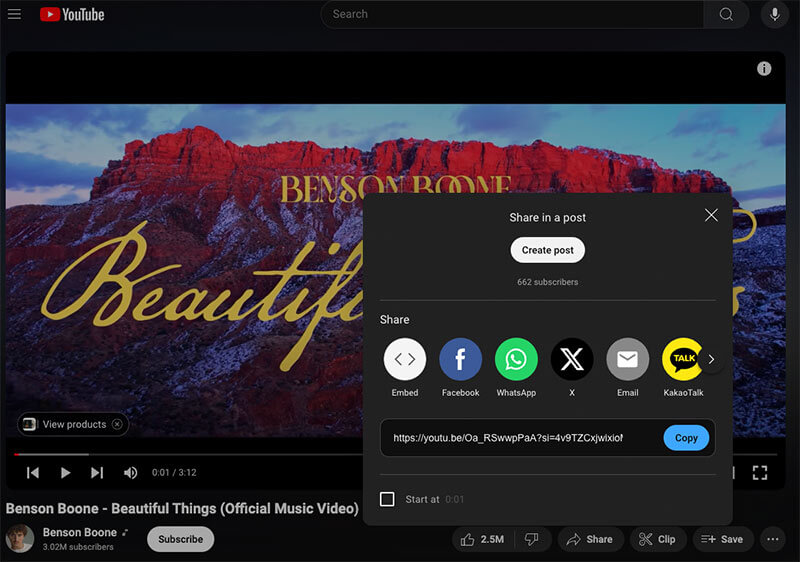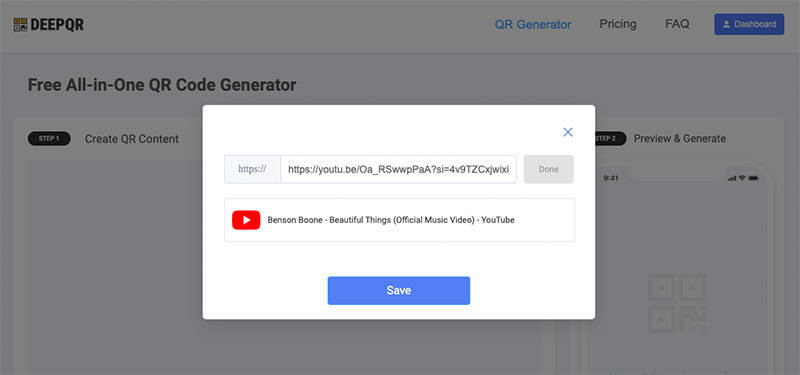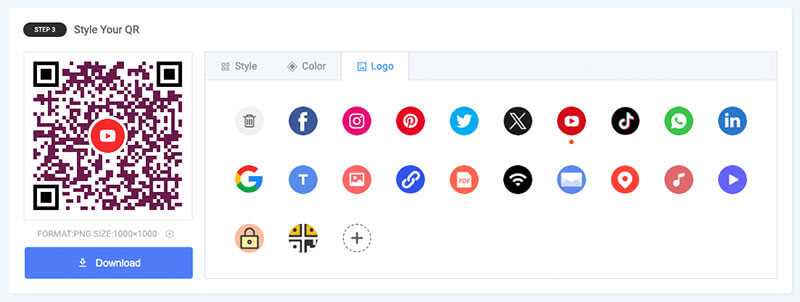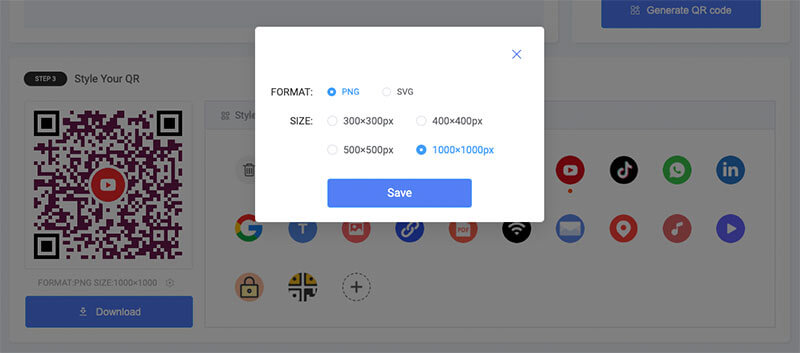How do you get a qr code from a youtube video
Step-by-Step Guide to Creating a YouTube Video QR Code
- Open the DeepQR website (DeepQR.com) homepage and click the "Add Components" button.
- Select the Link component, enter the YouTube video link, and click save.
- Preview the QR code scanning effect in real-time and click "Generate QR Code" to create the QR code.
- Click "Download" to download the QR code.
Preparing to Convert a YouTube Video Link to a QR Code
Before converting a YouTube video link to a QR code, some preparations are necessary.
Confirm Required Tools and Platforms
To create a YouTube video QR code, you will need a QR code generator. There are many brands available, but we recommend using an online QR code generator like DeepQR. Online generators do not require installation and are easy to use. DeepQR not only offers a free version but also provides extensive features, including the ability to create all-in-one QR codes that can embed multiple YouTube video links into a single QR code.
Obtain the YouTube Video Link

- Find the video you want to convert to a QR code.
- Click on the video to go to the video playback page. Click the "Share" button below the video and then select the "Copy Link" option. This will copy the video's URL to your clipboard.
Detailed Steps
Let's walk through the steps to convert a YouTube link into a QR code.
Log in to DeepQR Account (Register if You Don't Have One)
Open the DeepQR website (https://deepqr.com). If you're a first-time user, click "Dashboard" to register. The registration process is simple, and you can sign up using your Google account or email address.
Google Account Sign-In
Click "Dashboard" to bring up the sign-in panel. Select "Continue with Google" and follow the prompts to complete the registration without entering any information manually.
Email Address Sign-In
Enter your email address in the sign-in panel and click "Continue with Email". The system will send a confirmation email to the provided address. Open the email and click the confirmation link to complete your registration.
Regardless of the registration method, once registered, the site will keep you logged in, so you don't need to log in again next time.
Add the Link Component

On the homepage, you will see the QR code content editor. Click the "Add Components" button to open the components panel. Select the "Link" component, paste the YouTube link into the opened Link component panel, and click the "Done" button. The system will automatically parse the link and fetch the YouTube video title and logo information. Click the "Save" button to save it.
Preview and Generate the QR Code
After adding the Link component, you can see the scanning effect in the preview area. By default, the Combined Mode is selected. Switch to Solo Mode by clicking this button. In Solo Mode, users can directly open the YouTube video upon scanning, which meets our expectations better.
Click the "Generate QR Code" button below the preview area to create the QR code. At this point, you have a YouTube QR code, but let's make it look better.
Adjust QR Code Style

DeepQR currently offers three QR code style adjustments: pattern style, color, and logo. Adjusting the style, color, or selecting a logo will change the QR code pattern in real-time. With some adjustments, you can quickly get an attractive and functional QR code.
Download the QR Code

Once the QR code is generated and styled, you need to download it for use. DeepQR offers PNG and SVG download formats. If the QR code is used for social media, websites, or other online purposes, select the PNG format. Choose the appropriate size based on your needs, with a maximum size of 1000x1000 pixels. If it's for printing, use the SVG format to ensure the QR code remains clear and sharp.
QR Code Usage Tips
To ensure your QR code works effectively, consider the following tips:
Ensure Clarity and Scannability
- Resolution: Ensure the QR code has a high enough resolution, especially when printing. Low resolution can cause the QR code to be blurry, affecting scanability.
- Size: The QR code should not be too small. A minimum size of 2 cm x 2 cm (about 0.8 inches x 0.8 inches) is recommended to ensure most devices can scan it easily.
- Contrast: The QR code color should have sufficient contrast with the background. Typically, a black QR code on a white background works best. Avoid using color combinations that are too similar, like light gray on white.
Avoid Placing QR Codes on Complex Backgrounds
- Simple Background: Place the QR code on a simple, single-color background. Complex background patterns can interfere with scanning devices' recognition.
- White Space: Ensure there is enough white space around the QR code (usually at least a quarter of the QR code size) to help scanning devices recognize it correctly.
- Avoid Obstructions: The QR code should not be obstructed by any objects, even partially, as this can affect scannability.
Regularly Test the QR Code
- Multi-Device Testing: After generating the QR code, test it with different devices (e.g., smartphones, tablets) to ensure it works across various devices.
- Regular Checks: Especially for long-term use, regularly test the QR code to ensure the link hasn't expired and the QR code isn't damaged.
- Timely Updates: If the link or content the QR code points to changes, update the QR code and retest its scannability and functionality.
By following these tips, you can ensure your QR code is scannable and effective in various usage scenarios, enhancing user experience.
Frequently Asked Questions
You might encounter some issues while using QR codes. Here are answers to common questions:
Why Can't My QR Code Be Scanned?
- Insufficient Resolution: A low-resolution QR code can be unrecognizable by scanning devices. Ensure the QR code is of sufficient resolution, especially when printed.
- Poor Contrast: Low contrast between the QR code and its background can affect scanning. Ensure the QR code color contrasts clearly with the background.
- Small Size: A QR code that is too small can be difficult to scan. The recommended minimum size is 2 cm x 2 cm (about 0.8 inches x 0.8 inches).
- Complex Background: Complex background patterns can interfere with scanning. Place the QR code on a simple background with enough white space.
- Damaged QR Code: Folds, smudges, or wear on the QR code can affect its scannability. Keep the QR code in good condition.
- Broken Link: The link the QR code points to may have expired or been deleted. Regularly check the link to ensure it works correctly.
How to Embed a Logo in a QR Code?
- First, generate a basic QR code. In DeepQR, click "Generate QR Code" to create a basic QR code.
- In the QR code style adjustment area, select the LOGO option. Open the LOGO panel, click on the desired LOGO to embed it into the QR code. You can also upload your own LOGO.
For more details on embedding a LOGO into a QR code, refer to (How to make a QR code with a logo).
References and Resources
- QR Code Essentials by Mark Roberti, ISBN: 978-1420080122
- "Understanding QR Code Technology" - QR Code.com. Link
- "Best Practices for QR Code Marketing" by the Mobile Marketing Association
- "QR Code Design Guidelines" - QR Code.com. Link
- YouTube Help Center - Link
- "QR Code Troubleshooting Guide" - QR Code.com. Link
- "How to Embed Logos in QR Codes" - QR Code Generator. Link
